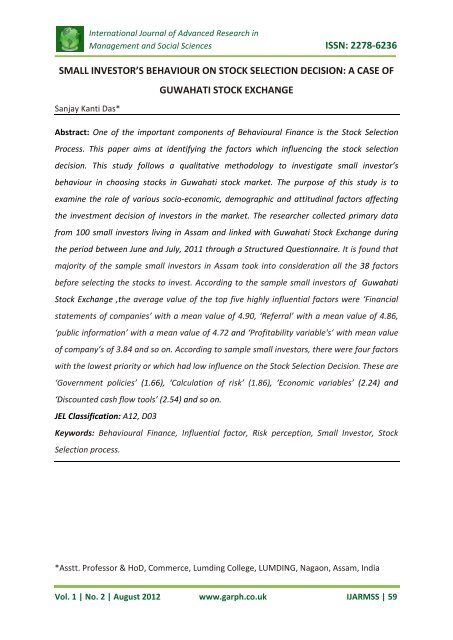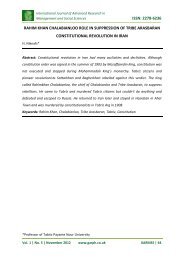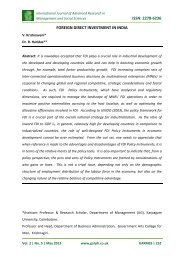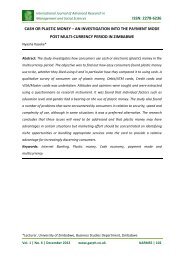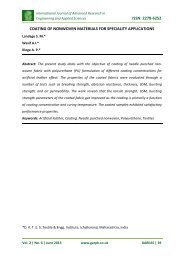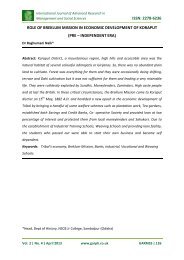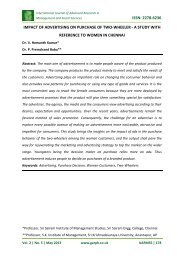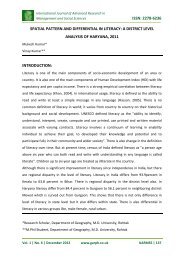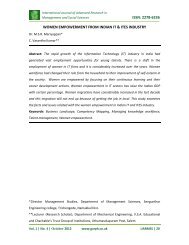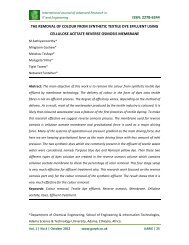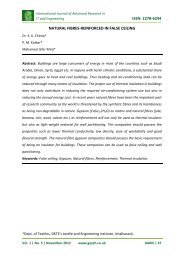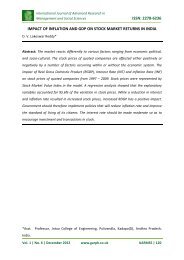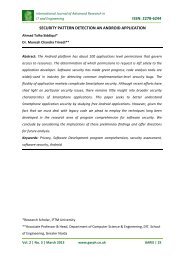issn: 2278-6236 small investor's behaviour on stock ... - Garph.co.uk
issn: 2278-6236 small investor's behaviour on stock ... - Garph.co.uk
issn: 2278-6236 small investor's behaviour on stock ... - Garph.co.uk
You also want an ePaper? Increase the reach of your titles
YUMPU automatically turns print PDFs into web optimized ePapers that Google loves.
Internati<strong>on</strong>al Journal of Advanced Research in<br />
Management and Social Sciences ISSN: <str<strong>on</strong>g>2278</str<strong>on</strong>g>-<str<strong>on</strong>g>6236</str<strong>on</strong>g><br />
SMALL INVESTOR’S BEHAVIOUR ON STOCK SELECTION DECISION: A CASE OF<br />
Sanjay Kanti Das*<br />
GUWAHATI STOCK EXCHANGE<br />
Abstract: One of the important <strong>co</strong>mp<strong>on</strong>ents of Behavioural Finance is the Stock Selecti<strong>on</strong><br />
Process. This paper aims at identifying the factors which influencing the <strong>stock</strong> selecti<strong>on</strong><br />
decisi<strong>on</strong>. This study follows a qualitative methodology to investigate <str<strong>on</strong>g>small</str<strong>on</strong>g> investor’s<br />
<str<strong>on</strong>g>behaviour</str<strong>on</strong>g> in choosing <strong>stock</strong>s in Guwahati <strong>stock</strong> market. The purpose of this study is to<br />
examine the role of various socio-ec<strong>on</strong>omic, demographic and attitudinal factors affecting<br />
the investment decisi<strong>on</strong> of investors in the market. The researcher <strong>co</strong>llected primary data<br />
from 100 <str<strong>on</strong>g>small</str<strong>on</strong>g> investors living in Assam and linked with Guwahati Stock Exchange during<br />
the period between June and July, 2011 through a Structured Questi<strong>on</strong>naire. It is found that<br />
majority of the sample <str<strong>on</strong>g>small</str<strong>on</strong>g> investors in Assam took into c<strong>on</strong>siderati<strong>on</strong> all the 38 factors<br />
before selecting the <strong>stock</strong>s to invest. Ac<strong>co</strong>rding to the sample <str<strong>on</strong>g>small</str<strong>on</strong>g> investors of Guwahati<br />
Stock Exchange ,the average value of the top five highly influential factors were ‘Financial<br />
statements of <strong>co</strong>mpanies’ with a mean value of 4.90, ‘Referral’ with a mean value of 4.86,<br />
‘public informati<strong>on</strong>’ with a mean value of 4.72 and ‘Profitability variable's’ with mean value<br />
of <strong>co</strong>mpany’s of 3.84 and so <strong>on</strong>. Ac<strong>co</strong>rding to sample <str<strong>on</strong>g>small</str<strong>on</strong>g> investors, there were four factors<br />
with the lowest priority or which had low influence <strong>on</strong> the Stock Selecti<strong>on</strong> Decisi<strong>on</strong>. These are<br />
‘Government policies’ (1.66), ‘Calculati<strong>on</strong> of risk’ (1.86), ‘Ec<strong>on</strong>omic variables’ (2.24) and<br />
‘Dis<strong>co</strong>unted cash flow tools’ (2.54) and so <strong>on</strong>.<br />
JEL Classificati<strong>on</strong>: A12, D03<br />
Keywords: Behavioural Finance, Influential factor, Risk percepti<strong>on</strong>, Small Investor, Stock<br />
Selecti<strong>on</strong> process.<br />
*Asstt. Professor & HoD, Commerce, Lumding College, LUMDING, Naga<strong>on</strong>, Assam, India<br />
Vol. 1 | No. 2 | August 2012 www.garph.<strong>co</strong>.<strong>uk</strong> IJARMSS | 59
Internati<strong>on</strong>al Journal of Advanced Research in<br />
Management and Social Sciences ISSN: <str<strong>on</strong>g>2278</str<strong>on</strong>g>-<str<strong>on</strong>g>6236</str<strong>on</strong>g><br />
INTRODUCTION<br />
The aim of <str<strong>on</strong>g>behaviour</str<strong>on</strong>g>al finance is to analyses the phenomena of market keeping in view the<br />
psychological factors involved in the <str<strong>on</strong>g>behaviour</str<strong>on</strong>g> of investors. Behavioural Finance mainly<br />
focuses <strong>on</strong> how investors interpret and act <strong>on</strong> micro and macro informati<strong>on</strong> to make<br />
investment decisi<strong>on</strong>s. Ac<strong>co</strong>rding to Kent et al. (2001), the most <strong>co</strong>mm<strong>on</strong> <str<strong>on</strong>g>behaviour</str<strong>on</strong>g> that<br />
most investors do when making investment decisi<strong>on</strong> are (1)Investors often do not<br />
participate in all asset and security categories, (2)Individual investors exhibit loss-averse<br />
<str<strong>on</strong>g>behaviour</str<strong>on</strong>g>, (3) Investors use past performance as an indicator of future performance in<br />
<strong>stock</strong> purchase decisi<strong>on</strong>s, (4)Investors trade too aggressively, (5) Investors behave <strong>on</strong> status<br />
quo, (6) Investors do not always form efficient portfolios, (7) Investors behave parallel to<br />
each other, and (8) Investors are influenced by historical high or low trading <strong>stock</strong>s. The<br />
propositi<strong>on</strong> that has dominated finance is Efficient Market Hypothesis (EMH). There are<br />
three basic theoretical arguments that form the basis of the EMH. The first and most<br />
significant is that investors are rati<strong>on</strong>al. Sec<strong>on</strong>dly it is based <strong>on</strong> the idea that every<strong>on</strong>e takes<br />
careful ac<strong>co</strong>unt of all available informati<strong>on</strong> before making investment decisi<strong>on</strong>s. It is related<br />
to internal c<strong>on</strong>sistency. The third principle is that the decisi<strong>on</strong> maker always pursues self-<br />
interest.<br />
The globalizati<strong>on</strong> of financial markets has increased the participati<strong>on</strong> and number of retail<br />
investors’ over the past two decades by providing a wide variety of market and investment<br />
opti<strong>on</strong>s. However, it makes their investment decisi<strong>on</strong>s process more <strong>co</strong>mplex. There are<br />
many investment products which are available for investment to investors in the <strong>stock</strong><br />
market ranging from b<strong>on</strong>ds to opti<strong>on</strong>s. These products vary with regard to risk factor<br />
involved and the return. Investors choose the investment products which have matching to<br />
their risk tolerance. Moreover, investor make up their mind regarding risk factor involved in<br />
any investment based <strong>on</strong> the financial informati<strong>on</strong> they receive from different channels or<br />
sources. Moreover, knowledge of investors regarding financial market and their past<br />
experience c<strong>on</strong>tribute a lot towards the risk assessment in various products. Investors who<br />
have experienced loss in the past formulate new investment decisi<strong>on</strong> having kept in mind<br />
their past experience. These factors al<strong>on</strong>g with some other factors c<strong>on</strong>stitute the risk<br />
aversi<strong>on</strong> and risk percepti<strong>on</strong> of the investors. After formulating risk attitudes the investors<br />
formulate their potential returns from that investment. Low return products are accepted if<br />
Vol. 1 | No. 2 | August 2012 www.garph.<strong>co</strong>.<strong>uk</strong> IJARMSS | 60
Internati<strong>on</strong>al Journal of Advanced Research in<br />
Management and Social Sciences ISSN: <str<strong>on</strong>g>2278</str<strong>on</strong>g>-<str<strong>on</strong>g>6236</str<strong>on</strong>g><br />
the risk attached with them is low and high risk products are selected if risk premium<br />
associate with risk level is offered to investors. Investors will invest in those products which<br />
offer the return suitable with the risk level of those products.<br />
With this percepti<strong>on</strong> about the individual investors, majority of trading strategies and <strong>stock</strong><br />
market policies are designed and focused to their instituti<strong>on</strong>al <strong>co</strong>unterparts, thereby<br />
ignoring the individual <str<strong>on</strong>g>investor's</str<strong>on</strong>g> interests to some extent. The purpose of this paper study is<br />
to analyse the attitudes and percepti<strong>on</strong>s of <str<strong>on</strong>g>small</str<strong>on</strong>g> investor’s and their <str<strong>on</strong>g>behaviour</str<strong>on</strong>g> in <strong>stock</strong><br />
selecti<strong>on</strong>.<br />
I. STATEMENT OF THE PROBLEM<br />
The research in Behavioural Finance is <strong>co</strong>mparatively less in India, when <strong>co</strong>mpared to other<br />
developed <strong>co</strong>untries. Within Behavioural Finance, it is assumed that informati<strong>on</strong> structure<br />
and the characteristics of market participants systematically influence individual’s<br />
investment decisi<strong>on</strong>s as well as market out<strong>co</strong>mes. The globalizati<strong>on</strong> of financial markets has<br />
been increasing the number of <str<strong>on</strong>g>small</str<strong>on</strong>g> investors over the past two decades by providing a<br />
wide variety of market and investment opti<strong>on</strong>s. However, it makes the investment decisi<strong>on</strong>s<br />
process much more <strong>co</strong>mplex. The <str<strong>on</strong>g>small</str<strong>on</strong>g> investors generally c<strong>on</strong>sider their investment needs,<br />
goals, objectives and c<strong>on</strong>straints while making investment decisi<strong>on</strong>s. But it is not possible<br />
for them to make a successful investment decisi<strong>on</strong> at all times. Their attitude is influenced<br />
by a variety of factors such as dividend, get rich quickly strategy, stories of successful<br />
investors, <strong>on</strong>line trading, investor awareness programme, etc. A better understanding of<br />
<str<strong>on</strong>g>behaviour</str<strong>on</strong>g>al processes and out<strong>co</strong>mes are important for financial planners because an<br />
understanding of how investors generally resp<strong>on</strong>d to market movements would help them<br />
in devising appropriate asset allocati<strong>on</strong> strategies for clients (Al-Tamimi, 2006). The <str<strong>on</strong>g>small</str<strong>on</strong>g><br />
investors c<strong>on</strong>sider their investment needs, goals, objectives and c<strong>on</strong>straints in making<br />
investment decisi<strong>on</strong>s, but it is not possible to make a successful investment decisi<strong>on</strong> at all<br />
times. It to be noted that there are many studies c<strong>on</strong>ducted in different <strong>co</strong>untries including<br />
India, but to the best of the researcher’s knowledge, a <strong>co</strong>mprehensive study <strong>co</strong>vering Assam<br />
has not been made. Further a study of this nature should be c<strong>on</strong>ducted at periodical interval<br />
as the attitude of investors’ keep changing. Hence, this study attempts to find out the<br />
factors influencing the <strong>stock</strong> selecti<strong>on</strong> decisi<strong>on</strong> of <str<strong>on</strong>g>small</str<strong>on</strong>g> investors of Assam and to study the<br />
attitude and percepti<strong>on</strong> of <str<strong>on</strong>g>small</str<strong>on</strong>g> investor’s of Assam.<br />
Vol. 1 | No. 2 | August 2012 www.garph.<strong>co</strong>.<strong>uk</strong> IJARMSS | 61
Internati<strong>on</strong>al Journal of Advanced Research in<br />
Management and Social Sciences ISSN: <str<strong>on</strong>g>2278</str<strong>on</strong>g>-<str<strong>on</strong>g>6236</str<strong>on</strong>g><br />
II. OBJECTIVE OF THE STUDY<br />
The main objective of the study is to analyze the <str<strong>on</strong>g>small</str<strong>on</strong>g> investors’ <str<strong>on</strong>g>behaviour</str<strong>on</strong>g> <strong>on</strong> Stock<br />
Selecti<strong>on</strong> Decisi<strong>on</strong>.<br />
III. HYPOTHESIS OF THE STUDY<br />
The study tested the following hypothesis and other <strong>co</strong>rollary hypothesis as indicated in the<br />
analysis.<br />
H 0 : The <str<strong>on</strong>g>small</str<strong>on</strong>g> investor’s firmly believe that many factors do influence their future<br />
investment.<br />
IV. METHODOLOGY OF THE STUDY<br />
The research design for the study is descriptive in nature. The researcher <strong>co</strong>llected primary<br />
data from the <str<strong>on</strong>g>small</str<strong>on</strong>g> investors living in Assam during the period between June and July, 2011<br />
through a Structured Questi<strong>on</strong>naire. The sample size <strong>co</strong>vered 100 <str<strong>on</strong>g>small</str<strong>on</strong>g> investors who were<br />
spread through five different business centers in Naga<strong>on</strong>, Kamrup, Tezpur, Cachar and<br />
Dibrugrah districts of Assam. The important business centers, where large number of<br />
investors is available, are identified for this study using Purposive Sampling Method. In<br />
order to <strong>co</strong>llect referred informati<strong>on</strong> from the <str<strong>on</strong>g>small</str<strong>on</strong>g> investors, the sampling design was<br />
carefully decided and properly chosen for the study. From each identified Investment<br />
Centre, five approved <strong>stock</strong> brokers were chosen and four investors were c<strong>on</strong>tacted with<br />
the help of <strong>stock</strong> sub-brokers. Thus, this study was based <strong>on</strong> the resp<strong>on</strong>ses by 100 selected<br />
resp<strong>on</strong>dents from the <str<strong>on</strong>g>small</str<strong>on</strong>g> investors.<br />
The resp<strong>on</strong>dents were asked to evaluate the importance of thirty eight variables (Clubbed<br />
into thirteen dependent variables) which were grouped from the survey of literature and<br />
pers<strong>on</strong>al interviews with select investors, brokers and sub-brokers, as important factors that<br />
influence the <str<strong>on</strong>g>small</str<strong>on</strong>g> investors in Stock Selecti<strong>on</strong> Decisi<strong>on</strong>. There were four choices against<br />
each of the 38 variables: “Str<strong>on</strong>gly agree” for the variables which had str<strong>on</strong>g influence <strong>on</strong><br />
the value of equity shares and “disagree” for the variables which did not have much<br />
influence <strong>on</strong> the Stock Selecti<strong>on</strong> Decisi<strong>on</strong>. The degree of each statement was determined<br />
using a four-point rating scale viz. Str<strong>on</strong>gly Agree =3, Agree = 2, Neutral = 1, and Disagree =<br />
0. The independent variables selected for this study are demographic characteristics,<br />
namely, gender, age, marital status, educati<strong>on</strong>al qualificati<strong>on</strong>, occupati<strong>on</strong>, number of family<br />
Vol. 1 | No. 2 | August 2012 www.garph.<strong>co</strong>.<strong>uk</strong> IJARMSS | 62
Internati<strong>on</strong>al Journal of Advanced Research in<br />
Management and Social Sciences ISSN: <str<strong>on</strong>g>2278</str<strong>on</strong>g>-<str<strong>on</strong>g>6236</str<strong>on</strong>g><br />
dependants, domicile and annual in<strong>co</strong>me and they were measured <strong>on</strong> nominal scale. The<br />
data whatsoever <strong>co</strong>llected were analysed through the applicati<strong>on</strong> of simple statistical tools.<br />
V. REVIEW OF LITERATURE<br />
A number of attempts have been made by researchers to identify the types of informati<strong>on</strong><br />
that investors need to choose a definite share. These studies have empirically identified the<br />
influential factors in choosing different <strong>stock</strong>s by surveying the <str<strong>on</strong>g>behaviour</str<strong>on</strong>g> of two levels of<br />
instituti<strong>on</strong>al and individual investors. Potter (1971) and Baker and Haslem (1974) observed<br />
several profitability variables such as dividends, rapid growth and quick profits beside other<br />
variables such as investment for saving purposes and l<strong>on</strong>g-term growth were empirically<br />
identified as effective factors <strong>on</strong> the attitudes of individual investors in making investment<br />
decisi<strong>on</strong>s. Peter (1970) carried out a study to identify those factors which motivate or guide<br />
the investment decisi<strong>on</strong>s of the <str<strong>on</strong>g>small</str<strong>on</strong>g> <strong>stock</strong> investors. The study identified factors such as<br />
in<strong>co</strong>me from dividends, rapid growth, purposeful investment as a protective outlet of<br />
savings and Professi<strong>on</strong>al investment management. In the study of Baker and Haslem (1973)<br />
importance of ac<strong>co</strong>unting informati<strong>on</strong> for investment decisi<strong>on</strong>s was identified as <strong>on</strong>e of the<br />
selecti<strong>on</strong> criteria. Financial statements were also found to be another important source of<br />
informati<strong>on</strong> for a minority of individual investors in some other studies. Further, evidence<br />
revealed that <strong>co</strong>rporate reports are dramatically c<strong>on</strong>sidered by investors as the most<br />
important sources of informati<strong>on</strong> for investment decisi<strong>on</strong>s (Abdulla, 1992). Ac<strong>co</strong>rding to<br />
importance of the various sources of <strong>co</strong>rporate informati<strong>on</strong>, Abu-Nassar and Rutherford<br />
(1996) argued that the annual <strong>co</strong>rporate reports are the most important source of<br />
informati<strong>on</strong> to make decisi<strong>on</strong> the different groups of investors. In a study, Naser et al.<br />
(2003) found that individual investors classify the annual report as the sec<strong>on</strong>d most<br />
important source of informati<strong>on</strong> and instituti<strong>on</strong>al investor’s rank annual reports as the main<br />
source of informati<strong>on</strong>. The evidence of Mirshekary and Saudagaran (2005) detected how<br />
investors apply the informati<strong>on</strong> items disclosed in the annual reports of financial statements<br />
for making investment decisi<strong>on</strong>s Also, Fisher and Statman (1997) believed that the<br />
investment decisi<strong>on</strong> is a <strong>co</strong>mplex process since an investor beside the risk and rate of return<br />
should c<strong>on</strong>sider several other financial and n<strong>on</strong> financial items. Moreover, in study of<br />
Whart<strong>on</strong>, an attempt to examine how demographic variables such as age, in<strong>co</strong>me,<br />
educati<strong>on</strong> level, etc., affect the investment choice and portfolio <strong>co</strong>mpositi<strong>on</strong> process was<br />
Vol. 1 | No. 2 | August 2012 www.garph.<strong>co</strong>.<strong>uk</strong> IJARMSS | 63
Internati<strong>on</strong>al Journal of Advanced Research in<br />
Management and Social Sciences ISSN: <str<strong>on</strong>g>2278</str<strong>on</strong>g>-<str<strong>on</strong>g>6236</str<strong>on</strong>g><br />
provided. Similarly, Blume and Friend (1978), using Whart<strong>on</strong> survey results, provided a<br />
<strong>co</strong>mprehensive study <strong>on</strong> implicati<strong>on</strong>s of <str<strong>on</strong>g>behaviour</str<strong>on</strong>g>al finance and found that basic measures<br />
of risk undertaken by individual investors are price and earning volatility. The study of Nagy<br />
and Obenberger (1994) developed a questi<strong>on</strong>naire that included 34 questi<strong>on</strong>s including<br />
financial and n<strong>on</strong>-financial items, that impact <strong>on</strong> shareholders’ percepti<strong>on</strong>. Their findings<br />
suggested that classical wealth–maximimizati<strong>on</strong> criteria are important to investors, even<br />
though investors employ diverse criteria when they choose the <strong>stock</strong>s. Shanmugam (1990)<br />
studied a group of 90 investors to examine the factors affecting investment decisi<strong>on</strong>. The<br />
study focused its analysis <strong>on</strong> the investment objective and the extent of awareness <strong>on</strong><br />
factors affecting investment decisi<strong>on</strong>. The study found that the Indian investors were high<br />
risk takers. The investors possessed adequate knowledge of government regulati<strong>on</strong>s,<br />
m<strong>on</strong>etary and fiscal policy. The research evidence of Shiller (2000) detected that <strong>stock</strong><br />
market is managed by the market informati<strong>on</strong> which directly affects the <str<strong>on</strong>g>behaviour</str<strong>on</strong>g> of the<br />
investors. Several demographics variable were empirically c<strong>on</strong>sidered such as gender, age<br />
and risk tolerance level of individuals to analyze the investor’s purchasing <str<strong>on</strong>g>behaviour</str<strong>on</strong>g>. Lihara<br />
et al. (2001) documented herding <str<strong>on</strong>g>behaviour</str<strong>on</strong>g> in various investors’ classes <strong>on</strong> the Tokyo Stock<br />
Exchange. The m<strong>on</strong>ey-flow instruments allowed the separati<strong>on</strong> of the measurement of<br />
sentiment from the measurement of asset returns. Krishnan and Booker (2002) analysed the<br />
influencing factors <strong>on</strong> decisi<strong>on</strong>s of those investors who use analyst’s re<strong>co</strong>mmendati<strong>on</strong>s to<br />
arrive at a short-term decisi<strong>on</strong> for holding or selling a definite <strong>stock</strong>. The research evidence<br />
of Hodge (2003) detected that the investors’ percepti<strong>on</strong>s of earnings quality, auditor<br />
independence, and the usefulness of audited financial informati<strong>on</strong> can influence investors’<br />
<str<strong>on</strong>g>behaviour</str<strong>on</strong>g> in choosing the <strong>stock</strong>, against lower percepti<strong>on</strong>s of earnings quality are<br />
associated with greater reliance <strong>on</strong> a firm’s audited financial statements and fundamental<br />
analysis of those statements when making investment decisi<strong>on</strong>s. Merikas et al. (2004)<br />
analyzed the factors influencing Greek investor’s <str<strong>on</strong>g>behaviour</str<strong>on</strong>g> <strong>on</strong> the Athens Stock Exchange.<br />
The results indicated that individuals base their <strong>stock</strong> purchase decisi<strong>on</strong> <strong>on</strong> ec<strong>on</strong>omic<br />
criteria <strong>co</strong>mbined with diverse other variables. Furthermore, the key role of prior<br />
informati<strong>on</strong> such as return c<strong>on</strong>tinuati<strong>on</strong>s to determine an appropriate <str<strong>on</strong>g>behaviour</str<strong>on</strong>g> patterns<br />
was identified as another influencing factor <strong>on</strong> investor’s decisi<strong>on</strong>s (Kadiyala and Rau, 2004).<br />
Chandra (2011) <strong>co</strong>llected the data from survey to know the factors influencing Indian<br />
Vol. 1 | No. 2 | August 2012 www.garph.<strong>co</strong>.<strong>uk</strong> IJARMSS | 64
Internati<strong>on</strong>al Journal of Advanced Research in<br />
Management and Social Sciences ISSN: <str<strong>on</strong>g>2278</str<strong>on</strong>g>-<str<strong>on</strong>g>6236</str<strong>on</strong>g><br />
individual investor <str<strong>on</strong>g>behaviour</str<strong>on</strong>g> in <strong>stock</strong> market. Using univariate and multivariate analysis and<br />
found five major factors that affect the investment <str<strong>on</strong>g>behaviour</str<strong>on</strong>g> of individual investor in <strong>stock</strong><br />
market namely prudence and precauti<strong>on</strong>s attitude, c<strong>on</strong>servatism, under c<strong>on</strong>fidence,<br />
informati<strong>on</strong>al asymmetry and financial additi<strong>on</strong> . Finally, he c<strong>on</strong>cluded that these are the<br />
major psychological <strong>co</strong>mp<strong>on</strong>ents seem to be influencing individual investor’s trading<br />
<str<strong>on</strong>g>behaviour</str<strong>on</strong>g> in Indian <strong>stock</strong> market. In additi<strong>on</strong>, Al-Tamimi (2006) indentified the factors<br />
influencing the UAE investor <str<strong>on</strong>g>behaviour</str<strong>on</strong>g>. Using questi<strong>on</strong>naire found six factors were most<br />
influencing factors <strong>on</strong> the UAE investor <str<strong>on</strong>g>behaviour</str<strong>on</strong>g> namely expected <strong>co</strong>rporate earnings, get<br />
rich quick, <strong>stock</strong> marketability past performance of the firm’s <strong>stock</strong>, government holdings<br />
and the creati<strong>on</strong> of the organised financial markets. The most influencing factors include<br />
<strong>co</strong>rporate earnings; get rich quick, past performance of the <strong>stock</strong>. Kannadhasan (2006)<br />
examined the factors that influence the <str<strong>on</strong>g>small</str<strong>on</strong>g> investor’s decisi<strong>on</strong> in investing. The decisi<strong>on</strong><br />
of the <str<strong>on</strong>g>small</str<strong>on</strong>g> investors are based <strong>on</strong> various dependent variables viz., Gender, age, marital<br />
status, educati<strong>on</strong>al level, in<strong>co</strong>me level, awareness, preference and risk bearing capacity.<br />
Mittal and Vyas (2007) have investigated how investment choices have been affected by the<br />
demographics of the investors. Such knowledge would be highly useful to the financial<br />
advisors as it would help them advise their clients regarding investments which are<br />
appropriate with respect to their demographic profile. The salaried class people preferred to<br />
invest their m<strong>on</strong>ey in equities and mutual funds while business classes have shown an<br />
inclinati<strong>on</strong> to invest their m<strong>on</strong>ey in debenture/b<strong>on</strong>ds and real estate or bulli<strong>on</strong>s. Ajmi (2008)<br />
used a questi<strong>on</strong>naire to know determinants of risk tolerance of individual investors and<br />
<strong>co</strong>llected resp<strong>on</strong>ses from 1500 resp<strong>on</strong>dents. He c<strong>on</strong>cluded that the men are less risk averse<br />
than women, less educated investors are less likely to take risk and age factor is also<br />
important in risk tolerance and also investors are more risk tolerance than the less wealthy<br />
investors. Maditinos et al. (2007) in his study stated that individual investors, while making<br />
investment decisi<strong>on</strong>, prefer to think more about the media, newspapers and noise in<br />
market, despite this, professi<strong>on</strong>al investor would rather c<strong>on</strong>centrate more <strong>on</strong> technical and<br />
fundamental analysis and less <strong>on</strong> portfolio analysis. In additi<strong>on</strong>, their evidence describe that<br />
all kind of investors ac<strong>co</strong>rding to ac<strong>co</strong>unting instruments, first look at the earnings (P/E) as<br />
their first priority and c<strong>on</strong>sider earnings per share (EPS) as their sec<strong>on</strong>d priority, later pay<br />
attenti<strong>on</strong> to the net operating profit after taxes (NOPAT) as their third priority, and finally,<br />
Vol. 1 | No. 2 | August 2012 www.garph.<strong>co</strong>.<strong>uk</strong> IJARMSS | 65
Internati<strong>on</strong>al Journal of Advanced Research in<br />
Management and Social Sciences ISSN: <str<strong>on</strong>g>2278</str<strong>on</strong>g>-<str<strong>on</strong>g>6236</str<strong>on</strong>g><br />
regard return <strong>on</strong> equity (ROE) as their fourth priority. Further, FASB (2008) emphasized key<br />
role of <strong>co</strong>rporate financial statement reports in choosing different <strong>stock</strong>s. To extend the<br />
FASB work, evidence of Al-Ajmi (2009) revealed that financial reporting should provide<br />
useful informati<strong>on</strong> for the potential investors, creditors and other users in making rati<strong>on</strong>al<br />
investment. Also, more evidence indicated that investors pay attenti<strong>on</strong> to several factors in<br />
choosing shares. These factors are involving historical profits, expectati<strong>on</strong> of a higher price<br />
of the <strong>stock</strong>, increase in the distributi<strong>on</strong> of cash dividends, newspaper and rumors from the<br />
market. Kabra et al. (2010) studied the factors effecting investment <str<strong>on</strong>g>behaviour</str<strong>on</strong>g> and<br />
c<strong>on</strong>cluded that investor’s age and gender are the main factors which decide the risk taking<br />
capacity of investors. Bennet and Selvam (2011) found out that SPERTEL risks had influenced<br />
the value of equity shares in the market. The market factors had influenced the <strong>stock</strong><br />
selecti<strong>on</strong> decisi<strong>on</strong> of <str<strong>on</strong>g>small</str<strong>on</strong>g> investors in India. Bennet et al. (2011) carried out a study and<br />
found that most of the investors expect the <strong>stock</strong> prices to go up to a degree greater than<br />
most of their investments. If the market has g<strong>on</strong>e down, they think it would rebound. If the<br />
market is up, they think it would go further. In either case, they make investment decisi<strong>on</strong><br />
<strong>on</strong> ac<strong>co</strong>unt of the assumpti<strong>on</strong> that the <strong>stock</strong> market would give better returns.<br />
In additi<strong>on</strong>, many other studies have identified several factors that have different levels of<br />
influencing investors’ decisi<strong>on</strong>s to buy and sell <strong>stock</strong>s. These factors which are classified by<br />
profitability variables, government policies, past <strong>stock</strong> price (return), firms’ public<br />
informati<strong>on</strong>, and c<strong>on</strong>sultative informati<strong>on</strong> are involving current and future profitability,<br />
dividends policy, government subsidies and support, <strong>stock</strong> price and future growth,<br />
members of the boards, line of business, and friends’ re<strong>co</strong>mmendati<strong>on</strong>s (Abdelsalam, 1990;<br />
Al-Razeen and Karbhari, 2004, 2007; Al-Attar and Al-Khater, 2007). To make investment<br />
decisi<strong>on</strong>s in the firms’ <strong>stock</strong>, investors expect the firms to disclose a set of informati<strong>on</strong><br />
about their financial positi<strong>on</strong>, sources of financial, management forecasts, investment<br />
programs, and financial policies. Meantime, investors obtain other types of informati<strong>on</strong><br />
from different sources. Generally, the literature evidence follows two areas of researches;<br />
some researches c<strong>on</strong>centrate empirically <strong>on</strong> instituti<strong>on</strong>s’ purchasing <str<strong>on</strong>g>behaviour</str<strong>on</strong>g> al<strong>on</strong>g with<br />
their influential determinants <strong>on</strong> <strong>stock</strong> selecti<strong>on</strong>, while other studies have generally focused<br />
up<strong>on</strong> individual <str<strong>on</strong>g>behaviour</str<strong>on</strong>g> in choosing different shares beside identificati<strong>on</strong> of their<br />
influencing factors. The literature evidence identify numerous influential factors which are<br />
Vol. 1 | No. 2 | August 2012 www.garph.<strong>co</strong>.<strong>uk</strong> IJARMSS | 66
Internati<strong>on</strong>al Journal of Advanced Research in<br />
Management and Social Sciences ISSN: <str<strong>on</strong>g>2278</str<strong>on</strong>g>-<str<strong>on</strong>g>6236</str<strong>on</strong>g><br />
classified based <strong>on</strong> below vital categorizes involving demographic levels, financial<br />
statements of <strong>co</strong>mpanies, ac<strong>co</strong>unting instruments, ec<strong>on</strong>omic variables, dis<strong>co</strong>unted cashflow<br />
tools, past <strong>stock</strong> price (return), c<strong>on</strong>sult with different resources, sec<strong>on</strong>d-hand<br />
informati<strong>on</strong> resources, firms’ public informati<strong>on</strong>, profitability variables, government policies,<br />
risk of <strong>stock</strong>, and past trading volume of <strong>stock</strong>s. Therefore, the extracted factors and their<br />
main categories are utilized as issues and topics discussed during the process of interview.<br />
After analysis of the existing literature <strong>on</strong> individual investor <str<strong>on</strong>g>behaviour</str<strong>on</strong>g> the main issues<br />
reported in the above studies can be summarized as follows:<br />
• There is no support for the overreacti<strong>on</strong> hypothesis.<br />
• Investor over-reacti<strong>on</strong> to a l<strong>on</strong>g series of bad news <strong>co</strong>uld produce predictable<br />
mispricing of <strong>stock</strong>.<br />
• Classical wealth-maximizati<strong>on</strong> criteria are important to investors.<br />
• The re<strong>co</strong>mmendati<strong>on</strong>s of brokerage houses, individual <strong>stock</strong> brokers, family members<br />
and <strong>co</strong>-workers go largely unheeded.<br />
• Investors exhibit a str<strong>on</strong>g demand for informati<strong>on</strong> about product safety and quality,<br />
and about the <strong>co</strong>mpany’s envir<strong>on</strong>mental activities.<br />
• There exist str<strong>on</strong>g forms of the analyst summary re<strong>co</strong>mmendati<strong>on</strong> report, which<br />
influence the <strong>stock</strong> selecti<strong>on</strong> decisi<strong>on</strong>s.<br />
• Individual investors are influenced by a number of psychological factors while making<br />
investment decisi<strong>on</strong>s.<br />
• The <str<strong>on</strong>g>behaviour</str<strong>on</strong>g> of individual investors caused by underlying sentiments has a<br />
significant relati<strong>on</strong>ship with the movements in <strong>stock</strong> prices.<br />
• Net trading by individual investors is a powerful predictor of future prices and returns<br />
that is not subsumed by either past returns or past volume.<br />
• Most of the studies are carried out in developed ec<strong>on</strong>omies c<strong>on</strong>text. Little evidence<br />
has been available from emerging ec<strong>on</strong>omies. This aspect particularly makes the<br />
present research study more relevant in Indian c<strong>on</strong>text. Studying Indian individual<br />
investors trading <str<strong>on</strong>g>behaviour</str<strong>on</strong>g> would seem an interesting propositi<strong>on</strong> for both the<br />
market stakeholders and the regulators and policy makers.<br />
From the above review, it is clear that there are some differences am<strong>on</strong>g the <str<strong>on</strong>g>small</str<strong>on</strong>g> investors<br />
<strong>on</strong> the factors that influence investors’ attitude towards investing in shares and <strong>stock</strong>s. It is<br />
Vol. 1 | No. 2 | August 2012 www.garph.<strong>co</strong>.<strong>uk</strong> IJARMSS | 67
Internati<strong>on</strong>al Journal of Advanced Research in<br />
Management and Social Sciences ISSN: <str<strong>on</strong>g>2278</str<strong>on</strong>g>-<str<strong>on</strong>g>6236</str<strong>on</strong>g><br />
to be noted that the literature <strong>on</strong> investor’s sentiment is still in its infancy, and much<br />
remains to be dis<strong>co</strong>vered and learnt. There is no <strong>co</strong>mprehensive study in India and<br />
particularly in Assam, focusing <strong>on</strong> market specific factors that influence investor’s<br />
sentiment. Hence this study, with the primary objective of analysing data <strong>on</strong> <str<strong>on</strong>g>small</str<strong>on</strong>g> investors<br />
attitudes and percepti<strong>on</strong>s about investment decisi<strong>on</strong>s and to identify the market specific<br />
factors that influence investors <strong>stock</strong> selecti<strong>on</strong> decisi<strong>on</strong>s.<br />
VI. ANALYSIS AND INTERPRETATION<br />
a) Key factors influencing Stock Selecti<strong>on</strong> Decisi<strong>on</strong><br />
Table 1 shows the Mean Value of each statement that <strong>co</strong>uld possibly influence the Stock<br />
Selecti<strong>on</strong> Decisi<strong>on</strong> of <str<strong>on</strong>g>small</str<strong>on</strong>g> investors in Assam and their respective ranks. Ac<strong>co</strong>rding to the<br />
sample <str<strong>on</strong>g>small</str<strong>on</strong>g> investors of Guwahati Stock Exchange ,the average value of the top five highly<br />
influential factors were ‘Financial statements of <strong>co</strong>mpanies’ with a mean value of 4.90,<br />
‘Referral’ with a mean value of 4.86, ‘public informati<strong>on</strong>’ with a mean value of 4.72 and<br />
‘Profitability variables’ with mean value of Firm’s of 3.84 and so <strong>on</strong>. Further, ac<strong>co</strong>rding to<br />
sample <str<strong>on</strong>g>small</str<strong>on</strong>g> investors of Guwahati Stock Exchange, there were four factors with the lowest<br />
priority and had low influence <strong>on</strong> the Stock Selecti<strong>on</strong> Decisi<strong>on</strong> which includes ‘Government<br />
policies’ (1.66), ‘Calculati<strong>on</strong> of risk’ (1.86), ‘Ec<strong>on</strong>omic variables’ (2.24) and ‘dis<strong>co</strong>unted cash<br />
flow tools’ (2.54) .<br />
Vol. 1 | No. 2 | August 2012 www.garph.<strong>co</strong>.<strong>uk</strong> IJARMSS | 68
Internati<strong>on</strong>al Journal of Advanced Research in<br />
Management and Social Sciences ISSN: <str<strong>on</strong>g>2278</str<strong>on</strong>g>-<str<strong>on</strong>g>6236</str<strong>on</strong>g><br />
Table I: Factors Influencing <strong>on</strong> Stock Selecti<strong>on</strong> Decisi<strong>on</strong>s.<br />
Effective factors in choosing<br />
<strong>stock</strong><br />
Total number of<br />
informants<br />
[n= 100]<br />
Average of s<strong>co</strong>res<br />
given by<br />
resp<strong>on</strong>ders<br />
Ranks<br />
I Financial statements of 70 4.90 I<br />
<strong>co</strong>mpanies<br />
Profit and loss statement<br />
Balance sheet<br />
Corporate financial statement<br />
reports<br />
Fund flow statement<br />
II Ac<strong>co</strong>unting Informati<strong>on</strong> 65 3.80 V<br />
Earnings per share<br />
Return <strong>on</strong> equity<br />
Net operating profit after taxes<br />
P/E<br />
III Sec<strong>on</strong>d hand informati<strong>on</strong> 65 2.83 VIII<br />
resources<br />
Newspapers<br />
Rumors in market<br />
Media<br />
IV Public informati<strong>on</strong> about 80 4.72 III<br />
Company<br />
Reputati<strong>on</strong> of the <strong>co</strong>mpany<br />
Protecti<strong>on</strong> of the investor<br />
Company status in industry<br />
Members profile of the board<br />
V Profitability variables 75 3.84 IV<br />
Dividends<br />
Current and future portability<br />
Quick profits<br />
Historical profits<br />
Expected <strong>co</strong>rporate earnings<br />
VI Referral 75 4.86 II<br />
C<strong>on</strong>sulting with the friend<br />
Majority <strong>stock</strong>holders<br />
Broker<br />
Coworker and <strong>co</strong>lleague<br />
VII Financial ratios 65 2.58 IX<br />
Profit and loss statement<br />
Cash flow statement<br />
Auditor’s report<br />
VIII Past trading volume of <strong>stock</strong>s 80 3.33 VII<br />
Vol. 1 | No. 2 | August 2012 www.garph.<strong>co</strong>.<strong>uk</strong> IJARMSS | 69
Internati<strong>on</strong>al Journal of Advanced Research in<br />
Management and Social Sciences ISSN: <str<strong>on</strong>g>2278</str<strong>on</strong>g>-<str<strong>on</strong>g>6236</str<strong>on</strong>g><br />
IX Past <strong>stock</strong> price trend 80 3.75 VI<br />
Stock price of two years<br />
Stock price of three years<br />
Stock price of more than five<br />
years<br />
X Dis<strong>co</strong>unted cash flow tools 60 2.54 X<br />
Net present value<br />
Internal rate of return<br />
Dividend dis<strong>co</strong>unt model<br />
Return <strong>on</strong> investment<br />
XI Government policies 30 1.66 XIII<br />
Government agencies<br />
XII Calculati<strong>on</strong> of risk 25 1.86 XII<br />
XIII Ec<strong>on</strong>omic variables 30 2.24 XI<br />
Market value added<br />
b) Financial statements<br />
All of our resp<strong>on</strong>dents (70%) use the financial statements of <strong>co</strong>mpanies in their evaluati<strong>on</strong>.<br />
The “profit and loss statement”, “<strong>co</strong>rporate financial statement reports” and “balance<br />
sheet” are being used more than others, where 56%, 28% and 16% respectively of<br />
resp<strong>on</strong>dents are using them. So, it may be c<strong>on</strong>cluded that most of them ensure that these 3<br />
statements will let them know a good image of financial background of the <strong>co</strong>mpany which<br />
they are investing in. However, resp<strong>on</strong>dents categorically assigned average s<strong>co</strong>re of 4.9 out<br />
of six as str<strong>on</strong>g influential factors in <strong>stock</strong> selecti<strong>on</strong> decisi<strong>on</strong>. This factor is, therefore, ranked<br />
as top influential factor in <strong>stock</strong> selecti<strong>on</strong> decisi<strong>on</strong> by the resp<strong>on</strong>dents of Guwahati Stock<br />
Exchange.<br />
c) Referral<br />
Based <strong>on</strong> the results (resp<strong>on</strong>se of 75% resp<strong>on</strong>dents) obtained through this study, more than<br />
28% of <str<strong>on</strong>g>small</str<strong>on</strong>g> investor’s c<strong>on</strong>sult with experts to give their re<strong>co</strong>mmendati<strong>on</strong> for making better<br />
investment decisi<strong>on</strong>. Only 12% rely <strong>on</strong> their pers<strong>on</strong>al experiences and knowledge. From<br />
those people who would like to c<strong>on</strong>sult with others, c<strong>on</strong>sulting with a friend and peer is<br />
selected as the most c<strong>on</strong>sulting method (42%). Sec<strong>on</strong>d priority of investors for making<br />
decisi<strong>on</strong> would be opini<strong>on</strong>s of the firm’s majority <strong>stock</strong>holders (10%) and the third is broker<br />
(8%). Finally, <strong>co</strong>lleague re<strong>co</strong>mmendati<strong>on</strong>s are placed <strong>on</strong> the first preferences respectively.<br />
However, resp<strong>on</strong>dents categorically assigned average s<strong>co</strong>re of 4.86 out of six as str<strong>on</strong>g<br />
influential factors in <strong>stock</strong> selecti<strong>on</strong> decisi<strong>on</strong>. Thus, this factor is, therefore, ranked as<br />
Vol. 1 | No. 2 | August 2012 www.garph.<strong>co</strong>.<strong>uk</strong> IJARMSS | 70
Internati<strong>on</strong>al Journal of Advanced Research in<br />
Management and Social Sciences ISSN: <str<strong>on</strong>g>2278</str<strong>on</strong>g>-<str<strong>on</strong>g>6236</str<strong>on</strong>g><br />
sec<strong>on</strong>d influential factor in <strong>stock</strong> selecti<strong>on</strong> decisi<strong>on</strong> by the resp<strong>on</strong>dents of Guwahati Stock<br />
Exchange.<br />
d) Public informati<strong>on</strong> about Company<br />
It is further observed that 80% of the resp<strong>on</strong>dents use firms’ public informati<strong>on</strong> in their<br />
evaluati<strong>on</strong>s to choose the <strong>stock</strong>. From the investors’ perspective, the reputati<strong>on</strong> of the firm<br />
has highest impact <strong>on</strong> their decisi<strong>on</strong> making. Further they menti<strong>on</strong> that the protecti<strong>on</strong> of<br />
the investor, profile of management and firm status in industry as the significant factors to<br />
influence decisi<strong>on</strong>s. However, resp<strong>on</strong>dents categorically assigned average s<strong>co</strong>re of 4.72 out<br />
of six as str<strong>on</strong>g influential factors in <strong>stock</strong> selecti<strong>on</strong> decisi<strong>on</strong>. This factor is, therefore, ranked<br />
third out of thirteen variables as top influential factor in <strong>stock</strong> selecti<strong>on</strong> decisi<strong>on</strong> by the<br />
resp<strong>on</strong>dents of Guwahati Stock Exchange.<br />
e) Profitability variables<br />
This study further reveals that 75% of the resp<strong>on</strong>dents use profitability variables to evaluate<br />
the <strong>stock</strong> performance. Profitability variables are mostly ratios and are defined as indicators<br />
of a firm’s success at making profits. It is observed that 75% of the resp<strong>on</strong>dents <strong>co</strong>mmented<br />
in respect to use profitability variables and c<strong>on</strong>sider current, future portability and quick<br />
profits through trading and historical profits as <strong>on</strong>e of the tool to assess the <strong>stock</strong><br />
performance but assigned low s<strong>co</strong>re (3.84).<br />
f) Ac<strong>co</strong>unting informati<strong>on</strong>’s<br />
A significant porti<strong>on</strong> of resp<strong>on</strong>dents (65%) use the ac<strong>co</strong>unting statements of <strong>co</strong>mpanies in<br />
their evaluati<strong>on</strong>. Informants <strong>co</strong>unt a few tools of ac<strong>co</strong>unting instruments which are able to<br />
help them in promoting their knowledge to purchase <strong>stock</strong>. The employed ac<strong>co</strong>unting<br />
instruments by resp<strong>on</strong>dents were in order of importance “earnings per share ”, “return <strong>on</strong><br />
equity ” and “net operating profit after taxes “. Further, P/E was less used ac<strong>co</strong>unting<br />
statement that resp<strong>on</strong>dents menti<strong>on</strong>ed. However, resp<strong>on</strong>dents categorically assigned<br />
average s<strong>co</strong>re of 3.8 out of six as str<strong>on</strong>g influential factors in <strong>stock</strong> selecti<strong>on</strong> decisi<strong>on</strong>. This<br />
factor is, therefore, ranked fifth out of six points as str<strong>on</strong>g influential factor in <strong>stock</strong><br />
selecti<strong>on</strong> decisi<strong>on</strong> by the resp<strong>on</strong>dents.<br />
g) Past <strong>stock</strong> price and trend<br />
This research shows that all investors (80% of the resp<strong>on</strong>dents) are unanimous <strong>on</strong> using<br />
historical <strong>stock</strong> price due to the fact that most investor’s predicti<strong>on</strong>s regarding future <strong>stock</strong><br />
Vol. 1 | No. 2 | August 2012 www.garph.<strong>co</strong>.<strong>uk</strong> IJARMSS | 71
Internati<strong>on</strong>al Journal of Advanced Research in<br />
Management and Social Sciences ISSN: <str<strong>on</strong>g>2278</str<strong>on</strong>g>-<str<strong>on</strong>g>6236</str<strong>on</strong>g><br />
price would be determined just by past <strong>stock</strong> prices. Based <strong>on</strong> this study, the major <str<strong>on</strong>g>small</str<strong>on</strong>g><br />
individual investors 50% of the resp<strong>on</strong>dents c<strong>on</strong>sider the past <strong>stock</strong> prices of two years for<br />
making decisi<strong>on</strong> whether to do the trade or not, as well as 15% of interviewees menti<strong>on</strong>s<br />
that they usually just look at the last year of the <strong>co</strong>mpany informati<strong>on</strong>. Only 25% trace the<br />
<strong>stock</strong> prices of three years ago. Finally, 10% c<strong>on</strong>sider the <strong>stock</strong> prices of more than 5 years<br />
ago to evaluate the performance of firm’s <strong>stock</strong>s.<br />
h) Past trading volume of <strong>stock</strong><br />
It is observed from the survey of literature that the trading volume is a critical and<br />
fundamental element to <strong>stock</strong> selecti<strong>on</strong> decisi<strong>on</strong>s. Volume is an indicator to measure the<br />
value of a share in terms of market share. If the markets price move up or down the<br />
strength of that move depends <strong>on</strong> the volume for that period. The higher the volume during<br />
that price move the more significant the move. Kent et al. (2001), in his study menti<strong>on</strong>ed<br />
that investors are influenced very much by historical performance of the <strong>stock</strong> price. Similar<br />
to these findings, Tvernsky and Karneman (1974) suggested the idea of anchoring where<br />
investors set a primary value for future prices. Further, Sultana (2010) observed that Indian<br />
investors make decisi<strong>on</strong> based <strong>on</strong> their own initiative, 60% resp<strong>on</strong>dents said they use past<br />
trading volume of the <strong>stock</strong>s, where 25% of them used less than 2 years historical data.<br />
However, 80% resp<strong>on</strong>dents categorically assigned average s<strong>co</strong>re of 3.33 out of six as str<strong>on</strong>g<br />
influential factors in <strong>stock</strong> selecti<strong>on</strong> decisi<strong>on</strong>. This factor is, therefore, ranked seventh out of<br />
thirteen variables as str<strong>on</strong>g influential factor in <strong>stock</strong> selecti<strong>on</strong> decisi<strong>on</strong> by the resp<strong>on</strong>dents.<br />
i) Sec<strong>on</strong>d-hand informati<strong>on</strong> resources<br />
The study explains that 65% of investors use the sec<strong>on</strong>d hand market informati<strong>on</strong>. Based <strong>on</strong><br />
our findings newspapers are the most <strong>co</strong>mm<strong>on</strong> sec<strong>on</strong>d-hand informati<strong>on</strong> sources am<strong>on</strong>g<br />
the other re<strong>co</strong>urses. So, many investors believe that, rumor has an important factor <strong>on</strong> the<br />
market price and they believe that by the rumor, sell the fact is an old trading rule, however,<br />
interpreted in<strong>co</strong>rrectly – the rules dictates that you do not have to sell the fact and not buy<br />
the fact. Further, <strong>on</strong> the basis of this survey, the media is thought of as the last sources of<br />
getting sec<strong>on</strong>d hand informati<strong>on</strong>. It is observed that 65% of the resp<strong>on</strong>dents <strong>co</strong>mmented in<br />
respect to use sec<strong>on</strong>d hand market informati<strong>on</strong> as <strong>on</strong>e of the tool to assess the <strong>stock</strong><br />
performance but assigned low s<strong>co</strong>re (2.83).<br />
Vol. 1 | No. 2 | August 2012 www.garph.<strong>co</strong>.<strong>uk</strong> IJARMSS | 72
Internati<strong>on</strong>al Journal of Advanced Research in<br />
Management and Social Sciences ISSN: <str<strong>on</strong>g>2278</str<strong>on</strong>g>-<str<strong>on</strong>g>6236</str<strong>on</strong>g><br />
j) Financial ratios<br />
Further, 65% of investors use the financial ratios in their evaluati<strong>on</strong>s to choose the <strong>stock</strong>.<br />
From those people who would like to take advantage of the financial ratios, c<strong>on</strong>sulting<br />
balance sheet is selected as most applied method. Ac<strong>co</strong>rding to this study, sec<strong>on</strong>d priority of<br />
investors is profit and loss statement while cash flow statement is c<strong>on</strong>sidered as the third<br />
priority. Finally, auditor’s report is <strong>on</strong>e of the essential tools <strong>on</strong> reporting financial<br />
informati<strong>on</strong> to users, especially in business. However, resp<strong>on</strong>dents categorically assigned<br />
average s<strong>co</strong>re of 2.58 out of six as str<strong>on</strong>g influential factors in <strong>stock</strong> selecti<strong>on</strong> decisi<strong>on</strong>. This<br />
factor is therefore ranked ninth out of thirteen variables as str<strong>on</strong>g influential factor in <strong>stock</strong><br />
selecti<strong>on</strong> decisi<strong>on</strong> by the resp<strong>on</strong>dents.<br />
k) Dis<strong>co</strong>unted cash-flow tools<br />
Ac<strong>co</strong>rding to the findings, 60% of the interviewees apply the dis<strong>co</strong>unted cash-flow means to<br />
evaluate their <strong>stock</strong> values. As it was explained in literature review, the IRR and NPV are<br />
most <strong>co</strong>mm<strong>on</strong> tools to <strong>co</strong>mpare and select investment opportunities. Each year's cash flow<br />
is dis<strong>co</strong>unted to the present, at a predetermined dis<strong>co</strong>unt rate, which reflects the project<br />
risk and the investors' minimum investment criteria. The NPV is the sum of these dis<strong>co</strong>unted<br />
annual cash flows. It is observed that NPV and IRR as the most <strong>co</strong>mm<strong>on</strong> tools am<strong>on</strong>gst<br />
investors, since 60% of the resp<strong>on</strong>dents who use dis<strong>co</strong>unted cash-flow most particularly<br />
NPV and IRR as their evaluati<strong>on</strong> methods. However, resp<strong>on</strong>dents categorically assigned<br />
average s<strong>co</strong>re of 2.54 out of six as str<strong>on</strong>g influential factors in <strong>stock</strong> selecti<strong>on</strong> decisi<strong>on</strong>. This<br />
factor is, therefore, ranked tenth out of thirteen variables as str<strong>on</strong>g influential factor in<br />
<strong>stock</strong> selecti<strong>on</strong> decisi<strong>on</strong> by the resp<strong>on</strong>dents.<br />
l) Ec<strong>on</strong>omic variables<br />
Using the ec<strong>on</strong>omic variables in evaluati<strong>on</strong>s of choosing the <strong>stock</strong> was a less used variable in<br />
the study (30%), as <strong>on</strong>e of them menti<strong>on</strong>ed that “those variables cannot be reliable<br />
variables”. However, a few of resp<strong>on</strong>dents are using, “market value added” as the ec<strong>on</strong>omic<br />
variable. However, resp<strong>on</strong>dents categorically assigned average s<strong>co</strong>re of 2.24 out of six as<br />
str<strong>on</strong>g influential factors in <strong>stock</strong> selecti<strong>on</strong> decisi<strong>on</strong>. This factor is, therefore, ranked<br />
eleventh out of thirteen variables as top influential factor in <strong>stock</strong> selecti<strong>on</strong> decisi<strong>on</strong> by the<br />
resp<strong>on</strong>dents.<br />
Vol. 1 | No. 2 | August 2012 www.garph.<strong>co</strong>.<strong>uk</strong> IJARMSS | 73
Internati<strong>on</strong>al Journal of Advanced Research in<br />
Management and Social Sciences ISSN: <str<strong>on</strong>g>2278</str<strong>on</strong>g>-<str<strong>on</strong>g>6236</str<strong>on</strong>g><br />
m) Calculati<strong>on</strong> of risk<br />
There are some methods to help the investors in calculating the risk but investors are not<br />
aware of those models. It is observed that 25% of the resp<strong>on</strong>dents menti<strong>on</strong>ed that they<br />
calculate the risk of their investment before investing in <strong>stock</strong>s for example they go for<br />
c<strong>on</strong>sultati<strong>on</strong> and they follow the exchange rate movements if the <strong>co</strong>mpany in multinati<strong>on</strong>al.<br />
Malkiel (1996) believed that an individual’s risk tolerance is related to his/her household<br />
situati<strong>on</strong>, lifecycle stage and subjective factors. Mittra (1995) also menti<strong>on</strong>ed some factors<br />
related to individuals risk tolerance, such as years until retirement, knowledge level and<br />
in<strong>co</strong>me. However, resp<strong>on</strong>dents categorically assigned average s<strong>co</strong>re of 1.86 out of six as<br />
str<strong>on</strong>g influential factors in <strong>stock</strong> selecti<strong>on</strong> decisi<strong>on</strong>. This factor is, therefore, ranked least<br />
influential factor in <strong>stock</strong> selecti<strong>on</strong> decisi<strong>on</strong> by the resp<strong>on</strong>dents of Guwahati Stock Exchange.<br />
n) Government policies<br />
Government policy and regulati<strong>on</strong>s can help investors make better decisi<strong>on</strong>s and will<br />
increase the market prices efficiency. Politics and government influence the <strong>stock</strong> market,<br />
for example it resp<strong>on</strong>ds to inflati<strong>on</strong> which is depends <strong>on</strong> m<strong>on</strong>etary policies (Bittlingmayer,<br />
1993). In spite of this fact, based <strong>on</strong> the results obtained through this survey, majority of our<br />
resp<strong>on</strong>dents prefer not to use government policies to evaluate and choose the <strong>stock</strong>s (30%).<br />
Am<strong>on</strong>gst those who rely <strong>on</strong> government policies, all interviewee menti<strong>on</strong>ed that they just<br />
use government agencies to evaluate their <strong>stock</strong>s. However, resp<strong>on</strong>dents categorically<br />
assigned average s<strong>co</strong>re of 1.66 out of six as str<strong>on</strong>g influential factors in <strong>stock</strong> selecti<strong>on</strong><br />
decisi<strong>on</strong>. This factor is, therefore, ranked least influential factor in <strong>stock</strong> selecti<strong>on</strong> decisi<strong>on</strong><br />
by the resp<strong>on</strong>dents.<br />
VII.<br />
CONCLUSION<br />
Indian <strong>stock</strong> market is c<strong>on</strong>sidered to be highly volatile, sensitive and reactive to<br />
unanticipated shocks and news and it takes no time to impact the market activities.<br />
However at the same time, Indian <strong>stock</strong> market is resilient and re<strong>co</strong>vers so<strong>on</strong> after shocks.<br />
The role and importance of individual investors and their trading <str<strong>on</strong>g>behaviour</str<strong>on</strong>g> in Indian <strong>stock</strong><br />
market is also very crucial. Unlike instituti<strong>on</strong>al investors, individual investors are believed to<br />
be less informed, have psychological biases and also thought of as the proverbial noise<br />
traders in the <strong>stock</strong> market. It is believed that trading <str<strong>on</strong>g>behaviour</str<strong>on</strong>g> of individual investors<br />
rarely influences the <strong>stock</strong> prices. With this percepti<strong>on</strong> about the individual investors,<br />
Vol. 1 | No. 2 | August 2012 www.garph.<strong>co</strong>.<strong>uk</strong> IJARMSS | 74
Internati<strong>on</strong>al Journal of Advanced Research in<br />
Management and Social Sciences ISSN: <str<strong>on</strong>g>2278</str<strong>on</strong>g>-<str<strong>on</strong>g>6236</str<strong>on</strong>g><br />
majority of trading strategies and <strong>stock</strong> market policies are designed and focused to their<br />
instituti<strong>on</strong>al <strong>co</strong>unterparts, thereby ignoring the individual <str<strong>on</strong>g>investor's</str<strong>on</strong>g> interests to some<br />
extent. From this research study it is found that majority of the sample <str<strong>on</strong>g>small</str<strong>on</strong>g> investors in<br />
Assam took into c<strong>on</strong>siderati<strong>on</strong> all the 38 factors before selecting the <strong>stock</strong>s to invest. The<br />
average value of the top five highly influential factors, ac<strong>co</strong>rding to the sample <str<strong>on</strong>g>small</str<strong>on</strong>g><br />
investors, were Financial statements of <strong>co</strong>mpanies with a mean value of 4.90, Referral with<br />
a mean value of 4.86, public informati<strong>on</strong> with a mean value of 4.72 and Profitability<br />
variables with mean value of Firm’s of 3.84 and so <strong>on</strong>. Ac<strong>co</strong>rding to sample <str<strong>on</strong>g>small</str<strong>on</strong>g> investors,<br />
there were four factors with the lowest priority or which had low influence <strong>on</strong> the Stock<br />
Selecti<strong>on</strong> Decisi<strong>on</strong>. These are Government policies (1.66), Calculati<strong>on</strong> of risk (1.86),<br />
Ec<strong>on</strong>omic variables (2.24) and dis<strong>co</strong>unted cash flow tools (2.54).<br />
REFERENCES<br />
1. Abdelsalam M. (1990). The use of <strong>co</strong>rporate financial reports by investors in Saudi<br />
Arabia. Journal of Advance Internati<strong>on</strong>al Ac<strong>co</strong>unting, 3(1), 25-39.<br />
2. Abdulla J. Y. A. (1992). Disclosure needs of major users of <strong>co</strong>rporate reports in<br />
Bahrain. Journal of Ec<strong>on</strong>omic Administrative Science, 8(1), 135-167.<br />
3. Abu-Nassar M and Rutherford B. A. (1996). External users of financial reports in less<br />
developed <strong>co</strong>untries: The case of Jord<strong>on</strong>, The British Ac<strong>co</strong>unting Review, 28(1), 73-<br />
87.<br />
4. Al-Ajmi J. (2009). Investor’s use of <strong>co</strong>rporate reports in Bahrain, Management Audit<br />
Journal, 24(3), 266-289.<br />
5. Al-Attar J M and Al-Khater K. (2007). An empirical instigati<strong>on</strong> of user’s views <strong>on</strong><br />
<strong>co</strong>rporate annual reports. Internati<strong>on</strong>al Journal of Communicati<strong>on</strong> and Management,<br />
17, 312-325.<br />
6. Al-Razeen A & Karbhari Y. (2004). Annual <strong>co</strong>rporate informati<strong>on</strong>: importance and use<br />
in Saudi Arabia. Management Audit Journal, 19(1), 117-133.<br />
7. Al-Tamimi, Hussein A. Hassan (2006). Factors influencing Individual Investor<br />
Behaviour: An empirical study of the UAE Financial Markets, The Business Review,<br />
Cambridge, Summer, 5(2), 225-232.<br />
8. Ajmi Jy. A. (2008). Risk Tolerance of Individual Investors in an Emerging Markets,<br />
Internati<strong>on</strong>al Research Journal of Finance and Ec<strong>on</strong>omics, 17 (2), 15-26.<br />
Vol. 1 | No. 2 | August 2012 www.garph.<strong>co</strong>.<strong>uk</strong> IJARMSS | 75
Internati<strong>on</strong>al Journal of Advanced Research in<br />
Management and Social Sciences ISSN: <str<strong>on</strong>g>2278</str<strong>on</strong>g>-<str<strong>on</strong>g>6236</str<strong>on</strong>g><br />
9. Bennet. E, Selvam. M, G. Indhumathi, R. Rajesh Ramkumar, V. Karpagam (2011).<br />
Factors Influencing Small Investors Attitude towards Investing In Equity Stocks: A<br />
Study in Tamil Nadu, Journal of Modern Ac<strong>co</strong>unting and Auditing, 7(3), 123-135.<br />
10. Bennet. E, and Selvam. M (2011). Investors’ percepti<strong>on</strong> towards the influence of<br />
SPERTEL risks <strong>on</strong> the value of equity shares. A Study c<strong>on</strong>ducted at Coimbatore City,<br />
Internati<strong>on</strong>al Journal of Research in Computer Applicati<strong>on</strong> and Management, 1 (2),<br />
61-65.<br />
11. Baker H K, Haslem J A. (1974). Toward the Development of Client-Specified Valuati<strong>on</strong><br />
Models. Journal of Finance, 29(4), 1255-1263.<br />
12. Baker K B H, Haslem J A. (1973). Informati<strong>on</strong> needs of individual investors, Journal of<br />
Ac<strong>co</strong>untancy, 5(2), 64-69.<br />
13. Blume M E and Friend I. (1978). The Changing Role of the Individual Investor. John<br />
Wiley & S<strong>on</strong>s, New York, New York.<br />
14. Chandra, Abhijeet and Kumar, Ravinder (2011). Determinants of Individual Investor<br />
<str<strong>on</strong>g>behaviour</str<strong>on</strong>g>: An Orthog<strong>on</strong>al Linear Transformati<strong>on</strong> Approach, available at<br />
http://mpra.ub.uni-uenchen.de/29722/MP.<br />
15. Daniel K, Hirshliefer D, Teoh S H. (2002). Investor Psychology in Capital Markets:<br />
Evidence and Policy Implicati<strong>on</strong>. Journal of M<strong>on</strong>etary Ec<strong>on</strong>omics, 49, 139-209.<br />
16. Financial Ac<strong>co</strong>unting Standard Board (2008). Statement of Financial Ac<strong>co</strong>unting<br />
C<strong>on</strong>cepts No. 2: Qualitative Characteristics of Ac<strong>co</strong>unting Informati<strong>on</strong>, available at:<br />
www.fasb.org/pdf/ aop_CON1.pdf.<br />
17. Fisher K L and Statman M (1997). The mean-variance optimizati<strong>on</strong> puzzle: Security<br />
portfolios and food portfolios. Financial Analysis Journal, 53(4), 41-50.<br />
18. Hodge F D. (2003). Investors’ percepti<strong>on</strong>s of earnings quality, auditor independence<br />
and the usefulness of audited financial informati<strong>on</strong>. Journal of Ac<strong>co</strong>unting Horiz<strong>on</strong>s,<br />
17, 37-48.<br />
19. Lihara, Yoshio, Hideaki Kiyoshi Kato and Toshifumi Tokunaga (2001). Investor’s<br />
Herding <strong>on</strong> the Tokyo Stock Exchange, Internati<strong>on</strong>al Review of Finance, 2(1), 71-98.<br />
20. Krishnan, R and Booker, D.M (2002). Investor’s Use of Analysts’ Re<strong>co</strong>mmendati<strong>on</strong>s,<br />
Behaviour Research in Ac<strong>co</strong>unting, 14, 129 – 158.<br />
21. Kannadhasan. M. (2006). Risk Appetite and Attitudes of Small Investors with Special<br />
Vol. 1 | No. 2 | August 2012 www.garph.<strong>co</strong>.<strong>uk</strong> IJARMSS | 76
Internati<strong>on</strong>al Journal of Advanced Research in<br />
Management and Social Sciences ISSN: <str<strong>on</strong>g>2278</str<strong>on</strong>g>-<str<strong>on</strong>g>6236</str<strong>on</strong>g><br />
Reference to Capital Market, The Management Ac<strong>co</strong>untant, June, 448 453.<br />
22. Kabra, G., Mishra, P.K. and Dash M.K. (2010). Factors Influencing Investment<br />
Decisi<strong>on</strong> of Generati<strong>on</strong>s in India: An Ec<strong>on</strong>ometric Study, Asian Journal of<br />
Management Research, 4 (2), 305-326<br />
23. Kadiyala P, Rau R. (2004). Investor reacti<strong>on</strong> to <strong>co</strong>rporate event announcement:<br />
Underreacti<strong>on</strong> or overracti<strong>on</strong>? Journal of Business, 77, 357-386.<br />
24. Kent D., Hirshleifer, and Siew H<strong>on</strong>g Teoh. (2001). Investor psychology in capital<br />
markets: evidence and policy implicati<strong>on</strong>s, Journal of M<strong>on</strong>etary Ec<strong>on</strong>omics, 49(1),<br />
139-209.<br />
25. Malkiel BG (1996). A random walk down Wall Street. New York: W. W. Nort<strong>on</strong> & Co.<br />
26. Mittal, Manish and Vyas R.K. (2007). Demographics and Investment Choice am<strong>on</strong>g<br />
Indian Investors, ICFAI Journal of Behavioural Finance, 4 (2), 12-20.<br />
27. Maditinos D, Sevic Z, Theriou N. (2007). Investo’rs <str<strong>on</strong>g>behaviour</str<strong>on</strong>g> in the Athens <strong>stock</strong><br />
exchange. Student’s Ec<strong>on</strong>omics & Finance, 24(1), 32-50.<br />
28. Merikas A A, Merikas A G, Vozikis G S, and Prasad D. (2004). Ec<strong>on</strong>omic Factors and<br />
Individual Investor Behaviour: The Case of the Greek Stock Exchange, Journal Applied<br />
Business Research, 20(4), 26-34.<br />
29. Mittra S (1995). Practicing financial planning: A <strong>co</strong>mplete guide for professi<strong>on</strong>als.<br />
Michigan: Mittra & Associates.<br />
30. Mirshekary S,and Saudagaran S M (2005). Percepti<strong>on</strong>s and characteristics of financial<br />
statement users in developing <strong>co</strong>untries: evidence from Iran. Internati<strong>on</strong>al Journal<br />
of Ac<strong>co</strong>unting, Auditing & Taxati<strong>on</strong>. 14, 33-54.<br />
31. Nagy R A, Obenberger R W. (1994). Factors influencing individual investor <str<strong>on</strong>g>behaviour</str<strong>on</strong>g>.<br />
Financial Analalysis Jounal, 50(4), 63-69.<br />
32. Naser K, Nuseibeh R (2003). User’s percepti<strong>on</strong> of <strong>co</strong>rporate reporting: evidence from<br />
Saudi Arabia. Journal of British Ac<strong>co</strong>unting Review, 35(2), 129-153.<br />
33. Peter Roger Ewing (1970). Motivating Factors Guiding the Comm<strong>on</strong> Stock Investor,<br />
Dissertati<strong>on</strong> Abstracts Internati<strong>on</strong>al, 31(5), 1975.<br />
34. Potter R E. (1971). An empirical study of motivati<strong>on</strong>s of <strong>co</strong>mm<strong>on</strong> <strong>stock</strong> investors.<br />
Southern Journal of Business, 6(1), 41-44.<br />
35. Shanmugam, K. (1990). A Study <strong>on</strong> Investor’s Awareness of Investment, Ph.D Thesis<br />
Vol. 1 | No. 2 | August 2012 www.garph.<strong>co</strong>.<strong>uk</strong> IJARMSS | 77
Internati<strong>on</strong>al Journal of Advanced Research in<br />
Management and Social Sciences ISSN: <str<strong>on</strong>g>2278</str<strong>on</strong>g>-<str<strong>on</strong>g>6236</str<strong>on</strong>g><br />
(Unpublished). Bharathiar University, India.<br />
36. Shiller R J. (2000). Irrati<strong>on</strong>al Exuberance Princet<strong>on</strong> University Press, Princet<strong>on</strong>.<br />
37. Sultana ST (2010). An Empirical Study of Indian Individual Investors’ Behaviour.<br />
Global Journal of Financial Management, 2(1), 19-33.<br />
38. Tvernsky A, Kahneman D. (1974). Judgment under uncertainty; Heuristics and biases.<br />
Journal Science, 185, 1124-1131.<br />
Vol. 1 | No. 2 | August 2012 www.garph.<strong>co</strong>.<strong>uk</strong> IJARMSS | 78


